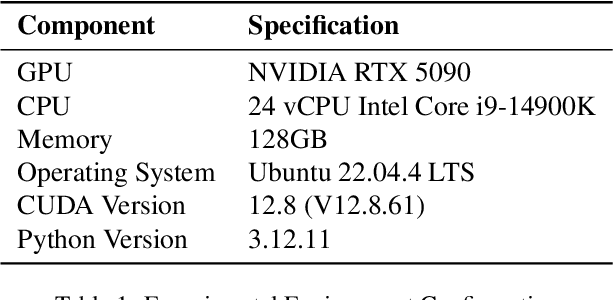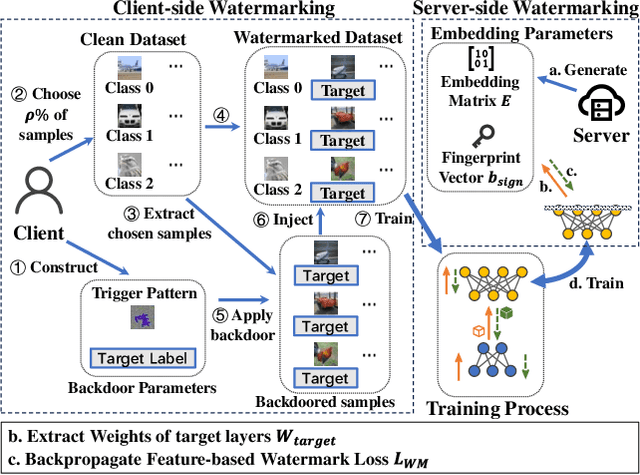Peng Sun
Tsinghua University
Optimizing Decoding Paths in Masked Diffusion Models by Quantifying Uncertainty
Dec 24, 2025Abstract:Masked Diffusion Models (MDMs) offer flexible, non-autoregressive generation, but this freedom introduces a challenge: final output quality is highly sensitive to the decoding order. We are the first to formalize this issue, attributing the variability in output quality to the cumulative predictive uncertainty along a generative path. To quantify this uncertainty, we introduce Denoising Entropy, a computable metric that serves as an internal signal for evaluating generative process. Leveraging this metric, we propose two algorithms designed to optimize the decoding path: a post-hoc selection method and a real-time guidance strategy. Experiments demonstrate that our entropy-guided methods significantly improve generation quality, consistently boosting accuracy on challenging reasoning, planning, and code benchmarks. Our work establishes Denoising Entropy as a principled tool for understanding and controlling generation, effectively turning the uncertainty in MDMs from a liability into a key advantage for discovering high-quality solutions.
Learning to Wait: Synchronizing Agents with the Physical World
Dec 18, 2025Abstract:Real-world agentic tasks, unlike synchronous Markov Decision Processes (MDPs), often involve non-blocking actions with variable latencies, creating a fundamental \textit{Temporal Gap} between action initiation and completion. Existing environment-side solutions, such as blocking wrappers or frequent polling, either limit scalability or dilute the agent's context window with redundant observations. In this work, we propose an \textbf{Agent-side Approach} that empowers Large Language Models (LLMs) to actively align their \textit{Cognitive Timeline} with the physical world. By extending the Code-as-Action paradigm to the temporal domain, agents utilize semantic priors and In-Context Learning (ICL) to predict precise waiting durations (\texttt{time.sleep(t)}), effectively synchronizing with asynchronous environment without exhaustive checking. Experiments in a simulated Kubernetes cluster demonstrate that agents can precisely calibrate their internal clocks to minimize both query overhead and execution latency, validating that temporal awareness is a learnable capability essential for autonomous evolution in open-ended environments.
Sigil: Server-Enforced Watermarking in U-Shaped Split Federated Learning via Gradient Injection
Nov 18, 2025Abstract:In decentralized machine learning paradigms such as Split Federated Learning (SFL) and its variant U-shaped SFL, the server's capabilities are severely restricted. Although this enhances client-side privacy, it also leaves the server highly vulnerable to model theft by malicious clients. Ensuring intellectual property protection for such capability-limited servers presents a dual challenge: watermarking schemes that depend on client cooperation are unreliable in adversarial settings, whereas traditional server-side watermarking schemes are technically infeasible because the server lacks access to critical elements such as model parameters or labels. To address this challenge, this paper proposes Sigil, a mandatory watermarking framework designed specifically for capability-limited servers. Sigil defines the watermark as a statistical constraint on the server-visible activation space and embeds the watermark into the client model via gradient injection, without requiring any knowledge of the data. Besides, we design an adaptive gradient clipping mechanism to ensure that our watermarking process remains both mandatory and stealthy, effectively countering existing gradient anomaly detection methods and a specifically designed adaptive subspace removal attack. Extensive experiments on multiple datasets and models demonstrate Sigil's fidelity, robustness, and stealthiness.
Robust Client-Server Watermarking for Split Federated Learning
Nov 17, 2025



Abstract:Split Federated Learning (SFL) is renowned for its privacy-preserving nature and low computational overhead among decentralized machine learning paradigms. In this framework, clients employ lightweight models to process private data locally and transmit intermediate outputs to a powerful server for further computation. However, SFL is a double-edged sword: while it enables edge computing and enhances privacy, it also introduces intellectual property ambiguity as both clients and the server jointly contribute to training. Existing watermarking techniques fail to protect both sides since no single participant possesses the complete model. To address this, we propose RISE, a Robust model Intellectual property protection scheme using client-Server watermark Embedding for SFL. Specifically, RISE adopts an asymmetric client-server watermarking design: the server embeds feature-based watermarks through a loss regularization term, while clients embed backdoor-based watermarks by injecting predefined trigger samples into private datasets. This co-embedding strategy enables both clients and the server to verify model ownership. Experimental results on standard datasets and multiple network architectures show that RISE achieves over $95\%$ watermark detection rate ($p-value \lt 0.03$) across most settings. It exhibits no mutual interference between client- and server-side watermarks and remains robust against common removal attacks.
Event-CausNet: Unlocking Causal Knowledge from Text with Large Language Models for Reliable Spatio-Temporal Forecasting
Nov 16, 2025Abstract:While spatio-temporal Graph Neural Networks (GNNs) excel at modeling recurring traffic patterns, their reliability plummets during non-recurring events like accidents. This failure occurs because GNNs are fundamentally correlational models, learning historical patterns that are invalidated by the new causal factors introduced during disruptions. To address this, we propose Event-CausNet, a framework that uses a Large Language Model to quantify unstructured event reports, builds a causal knowledge base by estimating average treatment effects, and injects this knowledge into a dual-stream GNN-LSTM network using a novel causal attention mechanism to adjust and enhance the forecast. Experiments on a real-world dataset demonstrate that Event-CausNet achieves robust performance, reducing prediction error (MAE) by up to 35.87%, significantly outperforming state-of-the-art baselines. Our framework bridges the gap between correlational models and causal reasoning, providing a solution that is more accurate and transferable, while also offering crucial interpretability, providing a more reliable foundation for real-world traffic management during critical disruptions.
AIonopedia: an LLM agent orchestrating multimodal learning for ionic liquid discovery
Nov 14, 2025Abstract:The discovery of novel Ionic Liquids (ILs) is hindered by critical challenges in property prediction, including limited data, poor model accuracy, and fragmented workflows. Leveraging the power of Large Language Models (LLMs), we introduce AIonopedia, to the best of our knowledge, the first LLM agent for IL discovery. Powered by an LLM-augmented multimodal domain foundation model for ILs, AIonopedia enables accurate property predictions and incorporates a hierarchical search architecture for molecular screening and design. Trained and evaluated on a newly curated and comprehensive IL dataset, our model delivers superior performance. Complementing these results, evaluations on literature-reported systems indicate that the agent can perform effective IL modification. Moving beyond offline tests, the practical efficacy was further confirmed through real-world wet-lab validation, in which the agent demonstrated exceptional generalization capabilities on challenging out-of-distribution tasks, underscoring its ability to accelerate real-world IL discovery.
ReSpec: Towards Optimizing Speculative Decoding in Reinforcement Learning Systems
Oct 30, 2025



Abstract:Adapting large language models (LLMs) via reinforcement learning (RL) is often bottlenecked by the generation stage, which can consume over 75\% of the training time. Speculative decoding (SD) accelerates autoregressive generation in serving systems, but its behavior under RL training remains largely unexplored. We identify three critical gaps that hinder the naive integration of SD into RL systems: diminishing speedups at large batch sizes, drafter staleness under continual actor updates, and drafter-induced policy degradation. To address these gaps, we present ReSpec, a system that adapts SD to RL through three complementary mechanisms: dynamically tuning SD configurations, evolving the drafter via knowledge distillation, and weighting updates by rollout rewards. On Qwen models (3B--14B), ReSpec achieves up to 4.5x speedup while preserving reward convergence and training stability, providing a practical solution for efficient RL-based LLM adaptation.
Bridging the Gap Between Ideal and Real-world Evaluation: Benchmarking AI-Generated Image Detection in Challenging Scenarios
Sep 11, 2025



Abstract:With the rapid advancement of generative models, highly realistic image synthesis has posed new challenges to digital security and media credibility. Although AI-generated image detection methods have partially addressed these concerns, a substantial research gap remains in evaluating their performance under complex real-world conditions. This paper introduces the Real-World Robustness Dataset (RRDataset) for comprehensive evaluation of detection models across three dimensions: 1) Scenario Generalization: RRDataset encompasses high-quality images from seven major scenarios (War and Conflict, Disasters and Accidents, Political and Social Events, Medical and Public Health, Culture and Religion, Labor and Production, and everyday life), addressing existing dataset gaps from a content perspective. 2) Internet Transmission Robustness: examining detector performance on images that have undergone multiple rounds of sharing across various social media platforms. 3) Re-digitization Robustness: assessing model effectiveness on images altered through four distinct re-digitization methods. We benchmarked 17 detectors and 10 vision-language models (VLMs) on RRDataset and conducted a large-scale human study involving 192 participants to investigate human few-shot learning capabilities in detecting AI-generated images. The benchmarking results reveal the limitations of current AI detection methods under real-world conditions and underscore the importance of drawing on human adaptability to develop more robust detection algorithms.
Causal Attention with Lookahead Keys
Sep 09, 2025Abstract:In standard causal attention, each token's query, key, and value (QKV) are static and encode only preceding context. We introduce CAuSal aTtention with Lookahead kEys (CASTLE), an attention mechanism that continually updates each token's keys as the context unfolds. We term these updated keys lookahead keys because they belong to earlier positions yet integrate information from tokens that appear later relative to those positions, while strictly preserving the autoregressive property. Although the mechanism appears sequential, we derive a mathematical equivalence that avoids explicitly materializing lookahead keys at each position and enables efficient parallel training. On language modeling benchmarks, CASTLE consistently outperforms standard causal attention across model scales, reducing validation perplexity and improving performance on a range of downstream tasks.
Collaborative Unlabeled Data Optimization
May 20, 2025Abstract:This paper pioneers a novel data-centric paradigm to maximize the utility of unlabeled data, tackling a critical question: How can we enhance the efficiency and sustainability of deep learning training by optimizing the data itself? We begin by identifying three key limitations in existing model-centric approaches, all rooted in a shared bottleneck: knowledge extracted from data is locked to model parameters, hindering its reusability and scalability. To this end, we propose CoOpt, a highly efficient, parallelized framework for collaborative unlabeled data optimization, thereby effectively encoding knowledge into the data itself. By distributing unlabeled data and leveraging publicly available task-agnostic models, CoOpt facilitates scalable, reusable, and sustainable training pipelines. Extensive experiments across diverse datasets and architectures demonstrate its efficacy and efficiency, achieving 13.6% and 6.8% improvements on Tiny-ImageNet and ImageNet-1K, respectively, with training speedups of $1.94 \times $ and $1.2 \times$.
 Add to Chrome
Add to Chrome Add to Firefox
Add to Firefox Add to Edge
Add to Edge